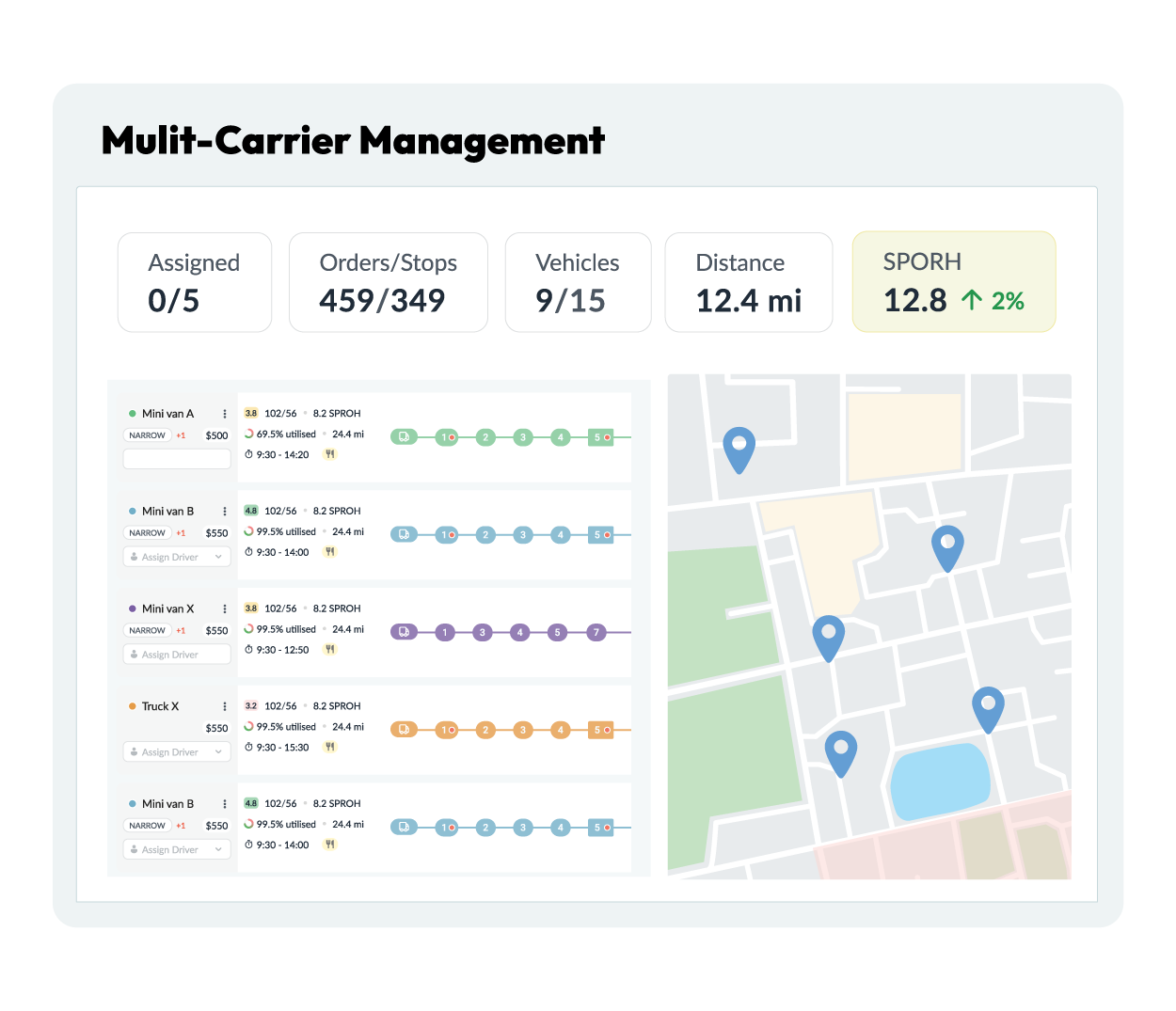- Route
The Importance of Real-Time Adjustments in Route Delivery Planning
Table of Contents
- Why Route Delivery Planning Needs Real-Time Agility
- The True Cost of Not Adjusting in Real Time
- Key Components of Real-Time Route Delivery Planning
- FarEye: Enabling Real-Time Route Delivery Planning
- FarEye AI-Based Routing in Action: Optimizing Express Pickups at Scale
- Business Impact of Real-Time Adjustments
- Closing the Loop: From Planning to Execution

Delivery environments are constantly evolving. Even with the most detailed plans in place, disruptions such as last-minute cancellations, traffic bottlenecks, or a spike in order volume can derail operations.
According to a recent report by American Transport Research Institute, traffic delays alone cost the U.S. trucking industry over $108.8 billion each year. For dispatchers and supply chain managers, staying agile in the face of such variability is essential for meeting service expectations and keeping operations lean.
This is where route delivery planning powered by real-time adjustments becomes critical. Enabled by AI and machine learning, routing platforms are reshaping traditional routing into a flexible, data-led system that keeps up with the pace of modern delivery demands.

Why Route Delivery Planning Needs Real-Time Agility
Route delivery planning is fundamentally about designing the most efficient way to get goods from the origin to the destination. Traditionally, this process involved manual mapping, often based on historical data or manual estimates. But the problem with traditional plans is simple: they don’t reflect the day-of realities.
Unexpected traffic congestion, sudden weather changes, last-minute cancellations, or bulk order additions can disrupt even the most well-crafted plans. This leads to missed delivery windows, increased fuel costs, and dissatisfied customers. Without real-time adaptability, minor disruptions quickly snowball into operational inefficiencies across the entire fleet.
Real-time route adjustments offer dispatchers a way to reclaim control. By incorporating live data from traffic APIs, GPS systems, weather reports, and order management systems, modern platforms allow for instant rerouting and workload redistribution. This translates to more on-time deliveries, fewer empty miles, and happier drivers.
The True Cost of Not Adjusting in Real Time
Failure to adapt delivery routes on the fly can lead to a cascade of inefficiencies:
- Missed delivery windows that reduce OTIF (On-Time, In-Full) performance and negatively affect customer satisfaction.
- Increased fuel consumption from detours and inefficient sequences
- Underutilized fleets due to outdated load assignments
- Driver frustration from overwork or misaligned shift plans
These challenges intensify when order volumes spike or when fleets operate across urban, suburban, and rural geographies. Planning delivery routes without a mechanism for real-time updates is like flying blind in turbulent air.
Key Components of Real-Time Route Delivery Planning
To be effective, real-time routing systems must integrate multiple layers of intelligence and data inputs. Here are the foundational components:
- Live Traffic and Geospatial Data
Integrating data from sources like Google Traffic or TomTom ensures that detours, congestion, or road closures are factored in automatically. - Driver Shift and Fleet Constraints
Effective systems account for Department of Transportation (DoT) compliance, break times, shift schedules, and driver skill sets while optimizing. - Smart Order Allocation
Whether it’s same-day parcels, big & bulky items, or refrigerated goods, every order comes with specific delivery needs. Real-time platforms must allocate orders based on capacity, location, priority, and service constraints. - Predictive Service Time Modeling
Route planning platforms enhance accuracy using advance service time modeling, which predicts how long each delivery will take based on historical patterns down to one-mile hexagonal zones. - Automated Rerouting and Notifications
If a customer cancels or changes their delivery time, rerouting must happen instantly. The system should also notify drivers and end customers without manual intervention.
FarEye: Enabling Real-Time Route Delivery Planning
FarEye stands out in this landscape by delivering an AI-first approach to route optimization. Designed for complex delivery networks, it addresses real-time challenges through a combination of automation, machine learning, and deep integration with transportation ecosystems.
What Makes FarEye Different?
- AI-powered routing engine that accounts for over 100+ constraints, including delivery sequence, vehicle type, and local regulations
- Helps dispatchers reduce planning time from hours to minutes, empowering teams to scale operations without delays or manual bottlenecks
- Rate-based routing that integrates private fleets and gig workers to reduce the cost per delivery
- Territory planning and auto-merge zoning to ensure equitable driver workloads
- Plug-and-play routing API for seamless OMS/TMS integration
By applying intelligent algorithms to planning delivery routes, FarEye helps businesses shift from reactive dispatching to proactive performance management.
FarEye AI-Based Routing in Action: Optimizing Express Pickups at Scale
A compelling example of real-time route delivery planning comes from a leading express logistics provider in Thailand. This company, managing over 70,000 daily pickup points with a mix of owned and outsourced fleets, faced rising operational complexity in its first-mile segment. Issues such as inefficient vehicle use, limited visibility, and manual dispatch planning hampered their scalability.
FarEye deployed its AI-powered route optimization engine to address these bottlenecks. Using 1.5 years of historical shipment data, the platform predicted expected volumes from each pickup point in advance. This allowed dispatchers to assign appropriate vehicle types and optimize cubic volume per trip. Dynamic routing ensured new pickup requests were allocated automatically to drivers without manual oversight.
Key outcomes:
- 60% reduction in vehicles needed to handle the same workload (from 300 to 130 vehicles)
- 70% reduction in planners/dispatchers required
- 40% reduction in driver count
- 66% faster dispatch process
This case highlights how predictive planning, automated routing, and embedded low-code workflows can turn high-volume logistics into a streamlined, scalable, and cost-efficient operation.
Business Impact of Real-Time Adjustments
The shift from traditional planning to real-time, AI-led routing is more than a tactical upgrade; it delivers measurable operational and financial outcomes across every stage of delivery execution.
| Metric | With Traditional Planning | With Real-Time Adjustments |
| SLA Adherence | ~82% | >95% |
| Delivery Cost per Order | Higher due to fuel & delays | Lower due to efficiency |
| Driver Productivity | Inconsistent | Balanced & optimized |
| Route Planning Time | 4-5 hours/day | ~30 minutes/day |
| Customer Satisfaction | Variable | Consistently high |
By automating real-time adjustments, businesses reduce the gap between planning and execution, converting logistical complexity into operational clarity.
Closing the Loop: From Planning to Execution
Real-time routing isn’t just about reacting to problems faster; it’s about creating a resilient logistics framework. One that uses historical performance to inform future planning, and live data to guide present decisions. In a landscape where customer expectations, fuel prices, and delivery volumes shift constantly, that kind of adaptability isn’t just valuable; it’s non-negotiable.
With FarEye, route delivery planning becomes a strategic asset. Through its AI-powered approach, businesses unlock faster decision-making, lower operational costs, and greater flexibility in how they serve customers. Whether you're handling 500 or 5,000 deliveries a day, it's not just about planning a delivery route anymore. It's about optimizing every mile in real time.
Source:
https://truckingresearch.org/2024/12/truckings-annual-congestion-costs-rise-to-108-8-billion/

Komal Puri is a seasoned professional in the logistics and supply chain industry. As the AVP of Marketing and a subject matter expert at FarEye, she has been instrumental in shaping the industry narrative for the past decade. Her expertise and insights have earned her numerous awards and recognition. Komal’s writings reflect her deep understanding of the industry, offering valuable insights and thought leadership.
Let's Talk to Our Experts and Optimize Your Deliveries Today!
An expert from our team will reach out within 24 hours


